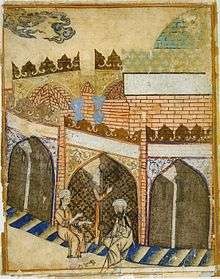Shanb Ghazan
Shanb-e-Ghazan, Ghazaniyya, or Sham-e-Ghazan (local pronunciation: Sham-Ghazan) is one of the historical neighborhoods of Tabriz, Iran. Shanb-e-Ghazan historical importance is mostly due to construction of a palace which later turned to the thumb / mausoleum of Ghazan Khan, the Ilkhanid emperor in late 13 and early 14th century.


History
At the time of the Ilkhanate and Arghun khan's kingdom in 1290 Shanb-e-Ghazan as a village named Shanb or Sham is changed into a large and populous town named Arghuniyye. The main parts of this construction included a Buddhist temple and a palace named Adiliyya.
At the time of king Mahmud Ghazan, Ghazan Khan, Shanb-e-Ghazan is evolved into a large satellite city of Tabriz called Ghazaniya. The neighborhood reached to its most prosperity at this time.
In late 1297 Ghazan Khan built his unique Tomb called Qubba-ye-Aali (Big Dome) in central part of the town and as he was interested a lot in benevolence, he ordered to build twelve charity building on all twelve sides of this building which consisted of : Jami Mosque, Khanqah, Hanafiyah School, Shafi'iyah School, Dar Al Siyadah, Observatory, Hospital, Library, Beit Al Qanun, Beit Al Motavalli, pool house, and Bathroom. There were other buildings such as orphanage, and Hakimiyya around this building.
Ghazan Khan's Dome with its 135 meters height astonished the visitors so that changed Shanb-e-Ghazan's other buildings to a scientific - cultural centre in its age. According to Ghazan Khan's order foreign merchants should pass and stay in Shanb-e-Ghazan in order to enter Tabriz. Ojan province's income and some villages, and one-tenth of objects entered to the treasury was allocated to Ghazaniyya. These factors all together made it as a town that was unique all over Iran (Mostofi- Nuhzat al Qoloub).
In later centuries, beside scientific cultural activities in this town, because of its strategic importance the land of this area was used as a battlefield of different countries.
At the time of Safavid it became more importance and Pargalı Ibrahim Pasha, Suleiman the Magnificent's minister, after occupying Tabriz made a castle in Shanb-e-Ghazan which was used later by Safavid and Ottoman Empire. Ottomans called Shanb-e-Ghazan "Dar Al Aman" (Safe Place); however Shah Abbas I of Safavid in order to prevent Ottomans' inhabitancy ordered to destroy all Ghazani buildings except for Tomb, Mosque, Khanqah, and probably one of the schools.
The earthquakes of 1641, 1650, and 1721 destroyed Shanb-e-Ghazan and its buildings a lot and miniaturized its residential area. The earthquake of the first morning of 1780 buried the remaining buildings. Thus from Ghazaniyyah just the south east part of it has been remained.
Shanb-e-Ghazan's antiquities because of the inadvertence of Qajar and Pahlavi government has been despoiled and it has led to this point that nowadays in this historical neighborhood there are no historical remains except for a bathroom and some scattered tiles.